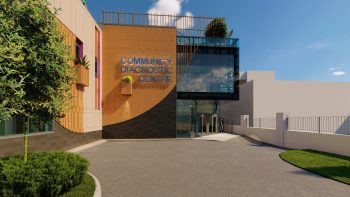A company that helps organisations reduce their carbon footprint and energy costs has become the first to design a method of harnessing waste heat from MRI machines.
Viridis Building Services devised the ground-breaking innovation as part of its work to deliver the UK’s first fully net zero Community Diagnostic Centre (CDC), in Scunthorpe town centre.
Not scheduled for completion until this autumn, the £19.4m Scunthorpe CDC new-build project is already on target to achieve net zero status, having been passed as such by Building Regulations and construction-stage EPC ratings.
Viridis was tasked to achieve as close as possible to net zero with the scheme but is confident that it will surpass expectations and create a building that will even be able to feed excess energy back into the National Grid.
The firm, based in Collingham, near Newark, has introduced a combination of natural and mechanical heating and ventilation, roof-mounted PV tiles and optimal lighting systems.
But as part of its problem-solving process, it has also pioneered a method for capturing the enormous amounts of rejected heat from the centre’s two MRI machines and feeding that energy back into the 2,000 sq. metre building.
This innovation alone could save the NHS millions of pounds in energy costs if the same method was introduced across its estate.
Lee Marshall, Managing Director of Viridis, said: “The knock-on benefits to this unique breakthrough could be huge.
“Not only have we delivered the UK’s first net zero Community Diagnostic Centre, we have also achieved a solution with the MRI heat recovery process that could save millions in energy bills and make a significant contribution to the reduction of the NHS’s carbon footprint.”
Scunthorpe CDC is one of the 160 Community Diagnostic Centres that the Government pledged to deliver before the end of 2024. The centres, which are being located in high-population areas close to public transport networks to provide easy patient access and encourage a reduction in car travel, will provide non-invasive treatments such as MRI scans, CT scans, ultrasounds and X-Rays.

Due to its strong reputation for delivering net zero buildings, Viridis was given a completely open brief with Scunthorpe CDC by Northern Lincolnshire & Goole NHS Foundation Trust.
“We were told they wanted a ‘nearly’ net zero building, as part of the NHS Estate’s commitment towards eventually achieving net zero across its entire portfolio,” said Lee.
“How we achieved that was effectively up to us. So we employed our usual process of combining each team member’s individual expertise in various disciplines to ask how we can exceed the brief and actually deliver a fully net zero building – within budget.
“We do not stop short at only implementing what has gone before. We always challenge the norms – and, like here, it often pays off.”
The Viridis team working on this project comprised of experts in mechanical engineering and electrical design, renewable energy and the environment.
The team’s first ideas focused on the thermal efficiency of the building – ways to contain heat and recover waste heat. They then began to look at various energy systems within the building, such as lighting, and came up with ways to optimise them to create maximum efficiency and minimum carbon emissions.
But the major breakthrough came about when the team began to investigate the enormous quantities of heat that are traditionally rejected from MRI machines.

The use of MRI machines as energy providers rather than energy wasters had never been done before. Heat produced by MRIs would normally be ‘disposed of’ through a fan to the outside atmosphere, whereas Viridis found a way to collect and re-use it with the use of heat pumps.
A building like Scunthorpe CDC would typically have expected to pay around £60k-£65k per year for its energy. But with the Viridis innovations, it is expected to have zero energy costs and figures indicate it may be able to sell around £1k of energy back to the Grid.



